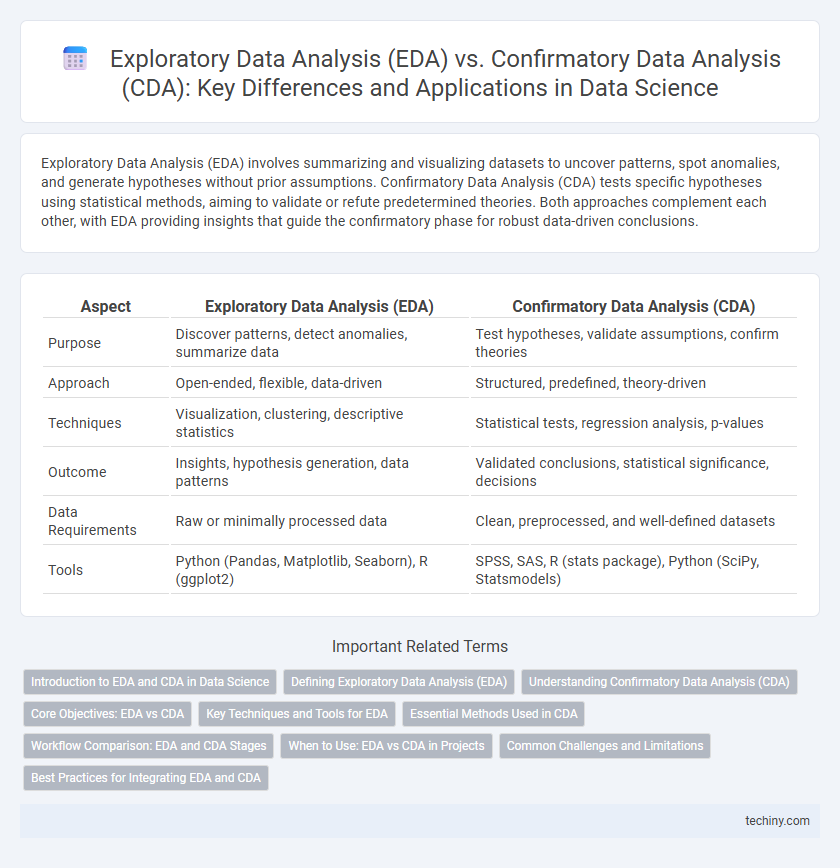Exploratory Data Analysis (EDA) involves summarizing and visualizing datasets to uncover patterns, spot anomalies, and generate hypotheses without prior assumptions. Confirmatory Data Analysis (CDA) tests specific hypotheses using statistical methods, aiming to validate or refute predetermined theories. Both approaches complement each other, with EDA providing insights that guide the confirmatory phase for robust data-driven conclusions.
Table of Comparison
| Aspect | Exploratory Data Analysis (EDA) | Confirmatory Data Analysis (CDA) |
|---|---|---|
| Purpose | Discover patterns, detect anomalies, summarize data | Test hypotheses, validate assumptions, confirm theories |
| Approach | Open-ended, flexible, data-driven | Structured, predefined, theory-driven |
| Techniques | Visualization, clustering, descriptive statistics | Statistical tests, regression analysis, p-values |
| Outcome | Insights, hypothesis generation, data patterns | Validated conclusions, statistical significance, decisions |
| Data Requirements | Raw or minimally processed data | Clean, preprocessed, and well-defined datasets |
| Tools | Python (Pandas, Matplotlib, Seaborn), R (ggplot2) | SPSS, SAS, R (stats package), Python (SciPy, Statsmodels) |
Introduction to EDA and CDA in Data Science
Exploratory Data Analysis (EDA) involves analyzing datasets to summarize their main characteristics, often using visual methods to detect patterns, anomalies, and relationships without prior hypotheses. Confirmatory Data Analysis (CDA) tests specific hypotheses through statistical techniques to validate assumptions and infer conclusions about data populations. Both EDA and CDA are crucial in the data science workflow, with EDA guiding the formulation of hypotheses and CDA providing rigorous validation.
Defining Exploratory Data Analysis (EDA)
Exploratory Data Analysis (EDA) involves summarizing the main characteristics of a dataset using visual methods such as histograms, scatter plots, and box plots to identify patterns, anomalies, or relationships without prior hypotheses. EDA emphasizes hypothesis generation and data-driven discovery by leveraging descriptive statistics and visualization techniques to inform further analysis. This initial investigative step contrasts with Confirmatory Data Analysis (CDA), which tests specific hypotheses using statistical inference.
Understanding Confirmatory Data Analysis (CDA)
Confirmatory Data Analysis (CDA) involves statistical techniques to test predefined hypotheses and validate assumptions derived from prior exploratory analysis. It emphasizes the use of inferential statistics, such as p-values and confidence intervals, to confirm relationships within the data with quantifiable confidence. CDA plays a crucial role in data science by enabling robust decision-making based on objective evidence rather than purely descriptive insights.
Core Objectives: EDA vs CDA
Exploratory Data Analysis (EDA) focuses on uncovering patterns, anomalies, and relationships within datasets to generate hypotheses through visualizations and summary statistics. Confirmatory Data Analysis (CDA) aims to test predefined hypotheses using statistical tests and inferential methods to validate findings with measurable confidence. EDA prioritizes data-driven discovery, while CDA emphasizes hypothesis testing and result confirmation in data science projects.
Key Techniques and Tools for EDA
Exploratory Data Analysis (EDA) utilizes techniques such as data visualization, summary statistics, and clustering to uncover patterns, detect anomalies, and test assumptions without prior hypotheses. Key tools for EDA include Python libraries like Pandas, Matplotlib, Seaborn, and interactive environments such as Jupyter Notebooks, which enable dynamic data exploration and visualization. In contrast, Confirmatory Data Analysis (CDA) relies on hypothesis testing, statistical inference, and modeling to validate predefined hypotheses using structured analytical frameworks.
Essential Methods Used in CDA
Confirmatory Data Analysis (CDA) primarily employs hypothesis testing, confidence intervals, and model validation techniques to statistically verify assumptions about data. Techniques such as t-tests, chi-square tests, ANOVA, and regression analysis are fundamental in confirming predefined hypotheses drawn from exploratory insights. CDA's rigorous approach ensures results are statistically significant and generalizable, distinguishing it from the pattern-discovering focus of Exploratory Data Analysis (EDA).
Workflow Comparison: EDA and CDA Stages
Exploratory Data Analysis (EDA) initiates the data science workflow by summarizing main characteristics through visualizations and descriptive statistics, emphasizing hypothesis generation and pattern recognition. Confirmatory Data Analysis (CDA) follows rigorous statistical testing to validate hypotheses, using inferential methods such as p-values, confidence intervals, and regression models. The EDA stage is iterative and open-ended, while CDA requires predefined hypotheses and structured methodologies to ensure analytical rigor and replicability.
When to Use: EDA vs CDA in Projects
Exploratory Data Analysis (EDA) is utilized at the initial stages of a data science project to uncover patterns, detect anomalies, and formulate hypotheses without predefined assumptions. Confirmatory Data Analysis (CDA) is applied after EDA to rigorously test hypotheses through statistical methods and validate findings with significance testing. EDA is essential for data understanding and preparation, while CDA is critical for hypothesis validation and drawing conclusions in data-driven decision-making.
Common Challenges and Limitations
Exploratory Data Analysis (EDA) often faces challenges such as subjective interpretation of patterns and potential overfitting due to extensive data slicing. Confirmatory Data Analysis (CDA) is limited by its reliance on predefined hypotheses, which can overlook unexpected insights and suffer from multiple testing problems. Both approaches struggle with data quality issues, including missing values and outliers that can skew results and reduce the validity of conclusions.
Best Practices for Integrating EDA and CDA
Integrating Exploratory Data Analysis (EDA) and Confirmatory Data Analysis (CDA) requires adopting iterative workflows that leverage EDA to generate hypotheses and CDA to rigorously test them using statistical methods. Best practices emphasize maintaining data integrity by ensuring preprocessing steps are consistent across both analyses, applying visualizations during EDA to detect patterns, and subsequently confirming findings through hypothesis-driven statistical tests in CDA. Utilizing automated tools and reproducible scripts enhances transparency and facilitates seamless transitions between exploration and confirmation phases in data science projects.
Exploratory Data Analysis (EDA) vs Confirmatory Data Analysis (CDA) Infographic

 techiny.com
techiny.com